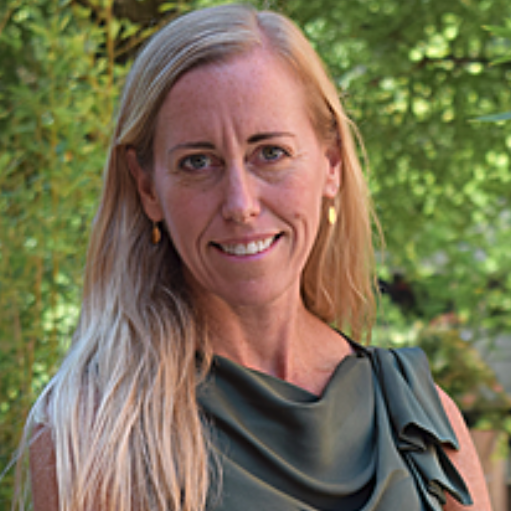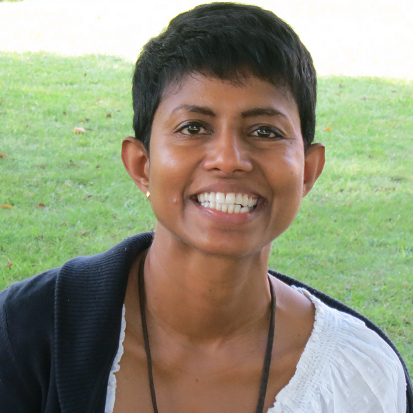Legend / Color-coding:
- MEPI (Mathematical Epidemiology)
- CDEV (Cell and Developmental Biology)
- EDUC (Education)
- IMMU (Immunobiology and Infection)
- NEUR (Mathematical Neuroscience)
- MFBM (Methods for Biological Modeling)
- POPD (Population Dynamics, Ecology & Evolution)
- ONCO (Mathematical Oncology)
- OTHE (Other)
Opening & Welcome
8:00am
Agent-based Modeling of Multi-Cellular Systems for Designing Better Therapies
Abstract: The most prevalent, devastating, and complex diseases of our time, such as diabetes, cardiovascular disease, and infectious diseases, involve the interactions of heterogeneous cells with one another and with their changing environment. However, the drugs we typically use to treat these diseases target a single protein (e.g. anti-vascular endothelial growth factor (VEGF) for treating diabetic retinopathy) and disregard the fact that cells within tissues are highly heterogeneous and have individualized responses that contribute to the tissue-level outcomes. To bridge the gap between protein and multi-cell/tissue-levels, my lab develops agent-based computational models and uses them in combination with experimental approaches, to predict how individual cell behaviors give rise to tissue-level adaptations. We have used agent-based modeling to simulate the structural adaptations of large and small blood vessels, skeletal muscle regeneration following injury, and immune cell trafficking and differentiation during inflammation and infection. Our studies have suggested new mechanistic hypotheses and provided suggestions for the design of novel therapies that account for the dynamic and heterogeneous interactions between different cell types within a diseased tissue.
Bio: Shayn Peirce-Cottler, Ph.D. is Professor of Biomedical Engineering with secondary appointments in the Department of Ophthalmology and Department of Plastic Surgery at the University of Virginia. Dr. Peirce-Cottler received Bachelor’s of Science degrees in Biomedical Engineering and Engineering Mechanics from The Johns Hopkins University in 1997. She earned her Ph.D. in the Department of Biomedical Engineering at the University of Virginia in 2002. Dr. Peirce-Cottler develops and uses computational models in conjunction with experiments to study structural and functional adaptations of tissues, in both health and disease, in order to develop new therapies for inducing regeneration in injured tissues or restoring homeostasis to diseased tissues. Her lab’s core expertise is in combining agent-based computational modeling with in vivo imaging of murine experimental models to examine and control the multi-cell interactions involved in angiogenesis. Current projects in her lab seek to exploit perivascular support cells, immune cells, and stem cells to invoke tissue regeneration and curb fibrosis during acute and chronic inflammation. Dr. Peirce-Cottler has published over 100 peer reviewed papers and book chapters, and she is the inventor on two issued U.S. Patents. She is a fellow in the American Institute for Medical and Biological Engineering College of Fellows and a Fellow of the Biomedical Engineering Society. She is also Past-President of The Microcirculatory Society. At UVA she teaches courses on computational modeling and cell and molecular physiology, and she is the Director of the Graduate Program in Biomedical Engineering.
Sub-group minisymposia (9:30-11:00am)
CDEV: Subgroup Contributed Talks (9:30-11:00am)
- Andrew Krause University of Oxford "Matching Theory to Real Biology: Recent Progress and Open Questions in Turing's Theory of Morphogenesis"
- Daniel Lobo University of Maryland, Baltimore County "A Turing system explains regeneration patterning and fission behavior in planaria"
- Jason Ko University of Maryland, Baltimore County "Regulated Cell Adhesion Dynamics in a Continuous Model: Sorting, Intercalation, and Involution"
- Timothy Ostler Cardiff University "Choosing the best embryo in In-Vitro Fertilization"
- Maria Abou Chakra University of Toronto "Control of tissue development by cell-cycle dependent transcriptional filtering"
MEPI: Modeling COVID-19 to inform control efforts, Part I (9:30-11:00am)
- Jonathan Read Lancatser University "Modelling early transmission of Covid-19 within China"
- Yanni Xiao Xi'an Jiaotang Univeresity "Modeling COVID-19 epidemic in mainland China based on multi-source data"
- Julien Riou University of Bern "Early transmission pattern and severity of COVID-19 in China"
- Zhilan Feng Purdue University "Staggered Release Policies for COVID-19 Control: Costs and Benefits of Relaxing Restrictions by Age and Risk"
MFBM: Simulations and Experiments in Small Scale Bio-Locomotion (9:30-11:00am)
- Orrin Shindell Trinity University, United States, oshindel@trinity.edu "Rigid Body Dynamics of Motile Bacteria near Surfaces"
- Meuriq Galagher University of Birmingham, United Kingdom, m.t.gallagher@bham.ac.uk "FAST: Automated Flagellar Capture as a Research and Clinical Tool"
- Suzanne Jacobs UT Austin, United States, sjacobs@chaos.utexas.edu "To Swarm or to Slide? Understanding the Mechanics of Bacterial Colony Expansion"
- Bruce Rodenborn Centre College, United States, bruce.rodenborn@centre.edu "Life at Low Reynolds Number in a Macroscopic Lab"
ONCO: Frontiers in MathOnco, Part 1 (9:30-11:00am)
- Morgan L. Craig Université de Montréal, Canada "Leveraging patient-specific heterogeneity to establish effective immunotherapeutic protocols"
- David Basanta Moffitt Cancer Center, Tampa, USA "Innocent bystander? The role of stromal cells in cancer evolution and treatment resistance"
- Kaitlyn Johnson University of Texas at Austin, USA "Towards an integrated framework for incorporating multimodal data sets into mechanistic models of treatment response dynamics in cancer"
- Khaphetsi Joseph Mahasa Lesotho "Mesenchymal stem cells used as carrier cells of oncolytic adenovirus results in enhanced oncolytic virotherapy"
POPD: Stochastic Population Dynamics (9:30-11:00am)
- Fima C. Klebaner Monash University "Appearance of random initial conditions in the Wright-Fisher model"
- Sophie Hautphenne Univeristy of Melbourne "Inference in population-size-dependent branching processes"
- Carmen Minuesa Abril Autonomous University of Madrid "Estimation of the carrying capacity in a population-size-dependent branching process"
- Göran Högnäs Åbo Akademi University "Exit times of some nonlinear autoregressive processes"
15 minute break (11:00-11:15am)
Sub-group minisymposia (11:15am)
CDEV: Modeling dynamics in single-cell biology (11:15am-12:45pm)
- Laleh Haghverdi Max Delbruck Center for Molecular Medicine, Berlin "Cell lineage trajectories and pseudotime reconstruction from single-cell transcriptomics"
- Adam MacLean University of Southern California "Inferring the structure and parameters of cell lineage models from single-cell data"
- Caleb Weinreb Harvard University "Limits on dynamic inference from single-cell RNA-seq and the case for additional measurements"
- Heyrim Cho University of California at Riverside "Modeling cell state dynamics of Hematopoiesis from single-cell gene sequencing data"
MEPI: COVID-19 Contributed Talks I (11:15am-12:45pm)
- Alun Lloyd North Carolina State University "Bidirectional contact tracing dramatically improves COVID-19 control"
- Grzegorz Rempala Ohio State University "Dynamical Survival Analysis for COVID-19 Predictions in Ohio"
- Adeshina Adekunle James Cook University "Delaying the COVID-19 epidemic in Australia: Evaluating the effectiveness of international travel bans"
- David JD Earn McMaster University "1918 vs 2020: Influenza vs COVID-19"
MFBM: Simulations and Experiments in Small Scale Bio-Locomotion (11:15am-12:45pm)
- Madeleine Hall Imperial College London, United Kingdom, madeleine.hall17@imperial.ac.uk "Optimal Turning Gaits for Undulators"
- David Smith University of Birmingham, United Kingdom, D.J.Smith@bham.ac.uk "Algorithmic Developments in the Method of Regularized Stokeslets for the Study of Micro-Locomotion"
- Hoa Nguyen Trinity University, United States, hnguyen5@trinity.edu "Effects of Cell Morphology, Attachment to a Surface, and Colony Formation on the Hydrodynamic Performance of Choanoflagellates"
- Genevieve O' Brien Johns Hopkins University, United States, gsteinobrien@jhmi.edu "Decomposing cell identity for transfer learning across cellular measurements, platforms, tissues, and species"
ONCO: Frontiers in MathOnco, Part 2 (11:15am-12:45pm)
- Mohit Kumar Jolly Indian Institute of Science, India "Integrating mechanism-based and data-based approaches to identify hybrid epithelial/mesenchymal phenotypes"
- Pamela Jackson Mayo Clinic, Phoenix, USA "Parameterizing a Brain Tumor Growth Model Using Noisy Simulated MRIs"
- Jeffrey West Moffitt Cancer Center, Tampa, USA "Anti-fragile Cancer Therapy"
- Anna Marciniak-Czochra University of Heidelberg, Germany "Stem cell niche dynamics in acute leukemia: Insights from mathematical modeling"
POPD: (11:15am-12:45pm)
- Swarnendu Banerjee Indian Statistical Institute, Kolkata "Chemical contamination mediated regime shifts in planktonic systems"
- Jody Reimer University of Utah "Long transient dynamics in the presence of noise"
- Carlos A. Braumann Universidade de Evora "General autonomous fishing models with Allee effects in a randomly varying environment"
- Toni Klauschies Potsdam University "Ecological and evolutionary causes of intermittent predator-prey cycles"
Mentoring Luncheon
Sub-group contributed talks (1:30-2:30pm)
CDEV: Subgroup Contributed Talks (1:30-2:30pm)
- Nathan Weinstein UNAM "A computational model of the differentiation of endothelial cells into macrophages"
- Aden Forrow University of Oxford "Learning developmental trajectories from CRISPR lineage tracing and single-cell gene expression"
- Claus Kadelka Iowa State "Unraveling the Design Principles of Gene Regulatory Networks: a Meta-Analysis"
MEPI: Subgroup Contributed Talks (1:30-2:30pm)
- Vijay Pal Bajiya Rajasthan University "The Impacts of Awareness and Medical Resources on Multi-group SIR Epidemic Model"
- Evan Mitchell Western University "The Effect of Host Prophylactic Behaviour on Pathogen Evolution"
- Jeremy D'Silva University of Michigan / Stanford University "Identifiability of linear compartmental models of infectious disease transmission"
MFBM: Subgroup Contributed Talks (1:30-2:30pm)
- Jinsu Kim University of California, Irvine "Stochastic epigenome systems under inflammatory signals and its application to study vivo nucleosome accessibility"
- Alan Rendall Johannes Gutenberg Universitat Mainz "Autophosphorylation as a source of multistability."
- Thomas Hillen University of Alberta "Non-local models for cellular adhesion"
ONCO: Subgroup Contributed Talks (1:30-2:30pm)
- Adam Malik Chalmers University of Technology, University of Gothenburg "Modelling glioblastoma growth and invasion using Diffusion Tensor Imaging-data"
- Emma Carrick Smith Wolfson Centre for Mathematical Biology, Mathematical Institute, University of Oxford "Modelling the Clonal Evolution of Drug-Resistant Cells in Non-Small Cell Lung Carcinoma"
- Arturo Araujo University of Roehampton "Multi-Scale Model of Colorectal Cancer Initiation"
OTHE: Other Contributed Talks (1:30-2:30pm)
- Gemma_Massonis CSIS "Structural Identifiability and Observability of Compartmental Models of the COVID-19 Pandemic"
- Cole Zmurchok Vanderbilt "Mechanosensing can enhance adaptation to maintain polarity of migrating cells"
- Thomas Fai Brandeis University "Length regulation of multiple flagella that self-assemble from a shared pool of components"
POPD: Subgroup Contributed Talks (1:30-2:30pm)
- Meike Wittmann Bielefeld University "A new maximum-likelihood method to infer factors influencing establishment success of introduced species"
- Candy Abboud University of Glasgow "Dating, localizing and predicting invasive-pathogen dynamics"
- Bo Zhang Oklahoma State University "Species competition in heterogeneous environments with directed movement"
Sub-group Keynote
3:30pm
Priyanga Amarasekare, University of California Los Angeles
Population Dynamics, Ecology, & Evolution Subgroup
Effects of climate warming on consumer-resource interactions
There is increasing evidence that climate warming is impacting biodiversity by disrupting species interactions. Trophic (consumer-resource) interactions, which comprise the fundamental units (modules) of food webs, are of particular importance because they have an intrinsic tendency to fluctuate in abundance, thus running to risk of stochastic extinction during periods of low abundances. Here I present a mathematical framework for predicting warming effects on consumer-resource interactions. This work differs from previous theory in two important ways. First, it uses delay differential equations to realistically depict the developmental delays inherent in ectotherm life cycles, and incorporates mechanistic descriptions of phenotypic trait responses, derived from first principles of thermodynamics, into the dynamical delay model. Second, it investigates the recent IPCC predictions on the increase in the number of hotter-than-average days. I report three key results. First, across latitudes (tropical vs. temperate) and feeding strategies (juvenile vs. adult attacked), a greater increase in the maximum temperature compared to the minimum (hotter-than-average summers) is more detrimental to consumer-resource interactions than a greater increase in the minimum temperature (warmer-than-average winters). Second, across latitude and warming scenarios, effects of warming are more detrimental when the consumer attacks the adult stage of the resource. Third, across warming scenarios and feeding strategies, consumer-resource interactions in the tropics are more at risk of species losses due to warming while those in the temperate zone are more at risk of extreme fluctuations in species' abundances. I discuss implications of these results for biodiversity and biological pest control.


